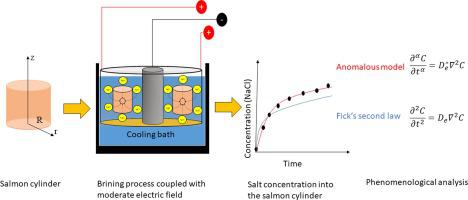Food Research International ( IF 7.0 ) Pub Date : 2020-07-06 , DOI: 10.1016/j.foodres.2020.109475 H. Núñez , G. Cavada , C. Ramírez , J. Moreno , G. Cornejo , A. Jaques , M. Pinto , O. Vega , R. Simpson

|
Salting is one of the oldest methods of preserving food. The main limitation of salting is its extended processing time due to slow salt diffusion. A moderate electric field (MEF) can improve the mass transfer rate through electroporation. Regularly, mass transfer processes are modeled with Fick’s second law. However, due to the anisotropic nature of food microstructures, it might be more appropriate to use an anomalous model.
The main objective of this study was to search for a phenomenological explanation for salt and water diffusion in the salmon brining process coupled with MEF.
Salmon fillets were cut into finite cylinders (0.025 × 0.025 m) and brined in two salt concentrations (6 and 24% w/w NaCl) at 6 °C for 20 h. MEFs were applied in the range of 0 to 2 V/cm. The salt and water contents of the salmon were measured during the process. Fick’s second law and anomalous model based on fractional calculus were used to describe the diffusion phenomena.
The results showed that an MEF tended to reduce the brining processing time and increase the salt content of salmon. This effect is predominantly due to an increase in the equilibrium salt concentration in the salmon tissue. Mathematical analysis shows that the anomalous diffusion model is more suitable for representing the brining process, exhibiting superdiffusion behavior (α > 1).
An MEF accelerates the salt mass transfer into salmon tissue even at lower temperatures, significantly reducing the processing time. In addition, the diffusion process can be characterized with an anomalous model.
中文翻译:

中度电场对大西洋鲑(Salmo salar)盐分的影响:实验研究和现象学理解
盐腌是保存食物的最古老的方法之一。盐腌的主要限制是由于盐扩散缓慢而延长了加工时间。适度的电场(MEF)可以通过电穿孔提高传质速率。通常,传质过程是用菲克第二定律建模的。但是,由于食物微结构的各向异性,使用异常模型可能更合适。
这项研究的主要目的是寻找鲑鱼养殖过程中结合MEF的盐和水扩散的现象学解释。
将鲑鱼片切成有限的圆柱体(0.025×0.025 m),并在6°C下以两种盐浓度(6和24%w / w NaCl)腌制20小时。MEF的施加范围为0至2 V / cm。在此过程中测量了鲑鱼的盐和水含量。使用基于分数演算的菲克第二定律和异常模型来描述扩散现象。
结果表明,MEF倾向于减少鲑鱼的腌制时间并增加盐分。这种作用主要是由于鲑鱼组织中平衡盐浓度的增加。数学分析表明,反常扩散模型更适合表示卤化过程,表现出超扩散行为(α> 1)。
即使在较低的温度下,MEF仍可加速盐类物质向鲑鱼组织的转移,从而大大减少了加工时间。另外,扩散过程可以用异常模型来表征。











































 京公网安备 11010802027423号
京公网安备 11010802027423号